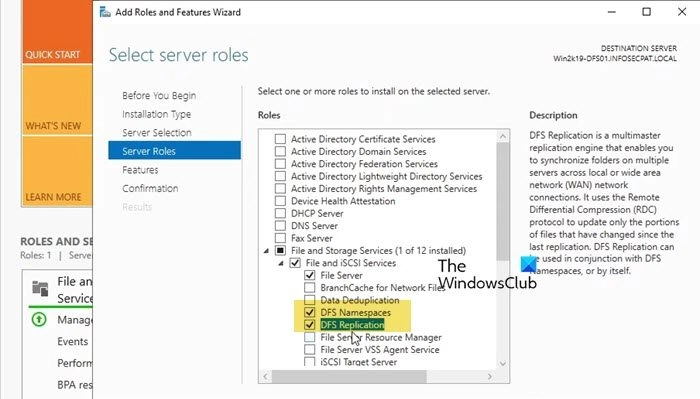
Distributed File System (DFS) is a replicated file share across multiple servers and locations to boost uptime and reduce access issues related to geography like latency and bandwidth. In this post, we will see how to configure DFS in Windows Server.
Distributed File System Replication (DFS Replication) is a feature in Windows Server that allows you to replicate folders across multiple servers and sites effectively. This includes replicating various types of folders, including those accessed through a DFS namespace path. In this post, we will discuss more about DFS Replication and DFS Namespace.
DFS is a role that you can add to your environment and then configure DFS Namespace and DFS Replication.
To get started with DFS in Windows Server, you need to go to the respective guides.
Let us talk about them in detail.
First, we need to add the DFS Role from Server Manager and include the necessary features to activate it. Follow the steps mentioned below to accomplish this.
Once the roles are added, we can proceed with the configuration.
Before configuring DFS Namespace, we recommend rebooting the server to ensure everything aligns correctly. After your server restarts, verify that all the services are running. You can check their status in the Server Manager itself.
After starting all the services, follow the below steps to create a DFS Namespace.
Once your Namespace is created, click on Close.
This way, we have created a Namespace or a shared folder that you can access using the name of the server. So, copy the actual path of the server, for example, if your server name is “Public”, and you have selected Domain-based Namespace, it would be something like ameSpaceServerName\Public. If you paste this name in Run (Win + R), you will be redirected to the shared path. However, it would be empty as we have yet to create a shared folder.
For that, follow these steps.
Since we now have a logical folder inside our namespace server, we should be able to get to it from Run. So, open Run, paste the actual path of the folder (that includes ameSpaceServerName\Public), and hit Enter.
Finally, you can map the drive to your File Explorer for easy access.
Read: How to Map Local Folder as Drive with letter in Windows 11
DFS Replication allows you to easily copy folders across multiple servers and sites, including the DFS namespace path folders. Before we go ahead with the tutorial, we recommend you enable the DFS Replication role as instructed in the first guide. After enabling it, follow the below steps.
The process will take some time, so, wait for the replication to be created. Once the replication process is completed, all data will be synced across both primary and secondary devices accessing the replicated folder.
If you want to replicate, go to Replication > Newly created replication member > Connections, right-click on the member, and select Replicate now. If there is already a schedule, you will be asked to override it. If you acknowledge it, you may encounter an error, meaning the synchronization is still in progress. So, you ought to wait for some time and attempt replication.
Hopefully, with the help of this tutorial, you can get started with Distributed File System in Windows Server.
Read: How to setup Branch Cache in Windows Server?
To set up DFS in Windows Server, you must first install DFS Namespace and DFS Replication roles from the Storage option. After installing these roles, you need to first configure DFS Namespace and then DFS Replication. We have provided a detailed tutorial on how to configure DFS in Windows Server, so, we recommend you to go through it once.
Also Read: Group Policy not replicating between Domain Controllers.
Published on July 26, 2024
Tags: Server
July 25, 2024
July 18, 2024
July 5, 2024
July 3, 2024
Hudson Valley Host is premier provider of cutting-edge hosting solutions, specializing in delivering a seamless online experience for businesses and individuals. We offer a comprehensive range of hosting services, including Shared Hosting, VPS, Dedicated Servers, and Colocation. With 24/7 technical support, robust security measures, and user-friendly control panels, we empower clients in managing their online presence effortlessly. Hudson Valley Host is your trusted partner in achieving online success.
For Inquiries or to receive a personalized quote, please reach out to us through our contact form here or email us at sales@hudsonvalleyhost.com.










